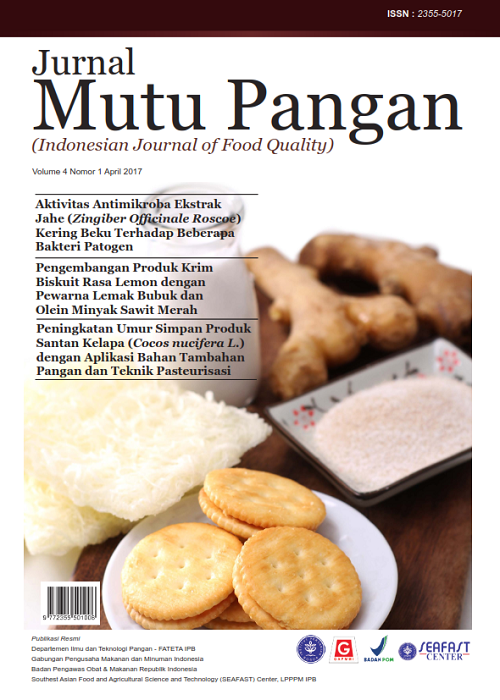Aktivitas Antimikroba Ekstrak Jahe Kering Beku Terhadap Beberapa Bakteri Patogen
Abstract
Ginger (Zingiber officinale Roscoe) has a potential as antimicrobial agent by inhibit or kill microbes. Freeze dried ginger extract is prepared for applying into food matrix easily. The objectives of this study was to evaluate the antimicrobial activity of freeze dried ginger extracts by multistage maceration using hexane, ethyl acetate and etanol against foodborne pathogen Staphylococcus aureus, Bacillus cereus and Salmonella enterica serovar Typhimurium. Ginger extracts were prepared by multistage maceration method using with different polarity of solvents i.e. hexane, ethyl acetate and etanol then freezed dried. Antimicrobial activity of the ginger extract were assayed by agar well diffusion method with Diameter Inhibition Zone (DIZ) and dillution broth method. The yield of hexane, ethyl acetate and etanol ginger extracts from multistage maceration were respectively 3.57; 3.17; 3.02 g/100 g dry ginger. The DIZ value of hexane, ethyl acetate and etanol ginger extracts for Staphylococcus aureus were 5.0, 5.7, 1.3 mm respectively and 6.1, 6.6, 6.0 mm for Bacillus cereus, however there was no inhibitory zone for Salmonella Typhimurium. The ethyl acetate ginger extract showed highest inhibition zone. The ethyl acetate ginger extract can reduced the growth of B.cereus and S. aureus as much as 85 and 47% from the normal growth level, however required higher concentration for reach 90% reduction.
Downloads
References
Akimoto M, Iizuka M, Kanematsu R, Yoshida M, Takenaga K. 2015. Anticancer effect of ginger extract against pancreatic cancer cells mainly through reactive oxygen species-mediated autotic cell death. PLoS ONE 10(5): e0126605. DOI: 10.1371/journal.pone.0126605.
Al-Zoreky NS, Nakahara K. 2003. Antibacterial activity of extracts from some edible plants commonly consumed in Asia. Int J Food Mic 80: 223–230. DOI: 10.1016/S0168-1605(02)00169-1.
[BAM] Bacteriological Analytical Manual. 2001. Aerobic plate count. http://www.fda.gov/Food/ ScienceResearch/LaboratoryMethods/BacteriologicalAnalyticalManualBAM/ucm063346.htm.
Agustus 2011].
[BPS] Badan Pusat Statistik. 2010. Luas panen, produksi dan produktivitas jahe 2010. http://www.bps.go.id/ tab_sub/view.php?tabel=1&daftar=1&id_subyek=55¬ab=8. [28 Juli 2011].
Bustan MD, Febriyani R, Pakpahan H. 2008. Pengaruh waktu ekstraksi dan ukuran partikel terhadap berat oleoresin jahe yang diperoleh dalam berbagai jumlah pelarut organik (metanol). J Tek Kim 4(15): 16–26.
[CDRH] Center for Devices and Radiological Health. 2009. Guidance for industry and FDA class II special controls guidance document: antimicrobial susceptibility test (AST) systems. http://www.fda. gov/downloads/MedicalDevices/DeviceRegulationandGuidance/GuidanceDocuments/ucm071462.pdf. [17 Agustus 2011].
Chan EWC, Lim YY, Wong LF, Lianto FS, Wong SK, Lim KK, Joe CE, Lim TY. 2008. Antioxidant and tyrosinase inhibition properties of and rhizomes of ginger species leaves. J Food Chem 109: 477–483. DOI: 10.1016/j.foodchem.2008.02.016.
Chrubasik S, Pittler MH, Roufogalis BD. 2005. Zingiberis rhizoma: a comprehensive review on the ginger effect and efficacy profiles. Phytomedicine 12(9): 684-701. DOI: 10.1016/j.phymed.2004.07. 009.
Coopoosamy RM, Naidoo KK, Buwa L, Mayekiso B. 2010. Screening of Siphonochilus aetiopicus (Schweinf.) B. L. Burtt for antibacterial and anti-fungal properties. J Med Plants Res 4(12): 1228-1231.
Cowan M. 2009. Plant product as antimicrobial agent. Clinical Microbiol Reviews 12(4): 564-582. DOI: 10.1128/CMR.12.4.564.
El-Baroty GS, El-Baky HHA, Farag RS, Saleh MA. 2010. Characterization of antioxidant and antimicrobial compounds of cinnamon and ginger essential oils. Afr J Bio Res 4(6): 167-174.
Fratiwi Y. 2015. The potential of guava leave (Psidium guajava L.) for diarrhea. J Majority 4(1): 113-118.
Johnny F, Roza D, Mastuti I. 2010. Aplikasi Imuno-stimulan untuk Meningkatkan imunitas Non-spesifik Ikan Kerapu Macan, Epinephelus fuscoguttatus terhadap Penyakit Infeksi di Hatchery. Prosiding Forum Inovasi Teknologi Akuakultur 2010. 945-949.
Jolad SD, Lantz RC, Solyom AM, Chen GJ, Bates RB, Timmermann BN. 2004. Fresh organically grown ginger (Zingiber officinale): composition and effects on LPS-induced PGE2 production. J Phyto 65: 1937–1954.
Mishra N, Behal KK. 2010. Antimicrobial activity of some spices against selected microbes. Int J Pharm Sci 2(3): 187-196.
Parhusip AJN. 2006. Kajian Mekanisme Antibakteri Ekstrak Andaliman (Zantoxylum acanthopodium DC) terhadap Bakteri Patogen Pangan. [Disertasi]. Bogor: Institut Pertanian Bogor.
Pepeljnjak S, Kalodera Z, Zovko M. 2005. Antimicrobial activity of flavonoid from Pelargonium radula (cav.) L’herit. Acta Pharm 55: 431-435.
Prescott LM, Harley JP, Klein DA. 2005. Microbiology Sixth Edition. McGraw-Hill Co Inc, New York.
Puengphian C, Sirichote A. 2008. [6]-gingerol content and bioactive properties of ginger (Zingiber officinale Roscoe) extracts from supercritical CO2 extraction. As. J Food Ag-Ind 1(01): 29-36.
Radiati LE. 2002. Mekanisme Penghambatan Virulensi Bakteri Entropatogen oleh Ekstrak Rimpang Jahe (Zingiber officinale Roscoe). [Disertasi]. Bogor: Institut Pertanian Bogor.
Rahminiwati M, Mustika AAP, Saadiah S, Andriyanto, Soeripto, Unang P. 2010. Bioprospeksi ekstrak jahe gajah sebagai anti-CRD: kajian aktivitas antibakteri terhadap Mycoplasma galliseptikum dan E. coli in vitro. J Ilmu Pertanian Indonesia 7-13.
Sagdic O, Yasar S, Kisioglu AN. 2005. Antibacterial effects of single or combined plant extracts. Annals Microbiol 55(1): 67-71.
Sari KIP, Periadnadi, Nasir N. 2013. Uji antimikroba ekstrak segar jahe-jahean (Zingiberaceae) terhadap Staphylococcus aureus, Escherichia coli, dan Candida albicans. J Bio UA 2(1): 20-24. ISSN: 2303-2162
Shan B, Cai YZ, Brooks JD, Corke H. 2007. The in vitro antibacterial activity of dietary spice and medicinal herb extracts. Int J Food Mic 117: 112–119. DOI: 10.1016/j.ijfoodmicro.2007.03.003.
Singh G, Kapoor IPS, Singh P, de Heluani CS, de Lampasona MP, Catalan CAN. 2008. Chemistry, antioxidant and antimicrobial investigations on essential oil and oleoresins of Zingiber officinale. J Food and Chem Tox 46: 3295–3302. DOI: 10.1016/j.fct.2008.07.017.
Singh J. 2008. Maceration, Percolation and Infusion Techniques for the Extraction of Medicinal and Aromatic Plants. Handa SS, Khanuja SPS, Longo G, Rakesh DD, editor. Extraction Technologies for Medicinal and Aromatic Plants. International Centre for Science and High Technology, Italia.
Todd ECD, Greig JD, Bartleson CA, Michaels BS. 2009. Outbreaks where food workers have been implicated in the spread of foodborne disease. Part 6. Transmission and survival of pathogens in the food processing and preparation environment. J Food Prot 72(1): 202–219. DOI: 10.4315/0362-028X-72.1.202.
Trusheva B, Trunkova D, Bankova V. 2007. Different extraction methods of biologically active components from propolis: a preliminary study. Chem Cen J 1: 13. DOI: 10.1186/1752-153X-1-13.
Wulandari R, Utami P, Hartanti D. 2009. Penapisan fitokimia dan uji aktivitas antibakteri ekstrak etanol herba pulutan (Urena lobata Linn.). Pharmacy 6(1): 5.

















